
The Hoxne Hoard is the largest hoard of late Roman silver and gold discovered in Britain, and the largest collection of gold and silver coins of the fourth and fifth centuries found anywhere within the former Roman Empire. It was found by Eric Lawes, a metal detectorist in the village of Hoxne in Suffolk, England in 1992. The hoard consists of 14,865 Roman gold, silver, and bronze coins and approximately 200 items of silver tableware and gold jewellery. The objects are now in the British Museum in London, where the most important pieces and a selection of the rest are on permanent display. In 1993, the Treasure Valuation Committee valued the hoard at £1.75 million.
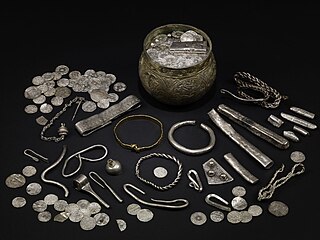
The Vale of York Hoard, also known as the Harrogate Hoard and the Vale of York Viking Hoard, is a 10th-century Viking hoard of 617 silver coins and 65 other items. It was found undisturbed in 2007 near the town of Harrogate in North Yorkshire, England. The hoard was the largest Viking one discovered in Britain since 1840, when the Cuerdale hoard was found in Lancashire, though the Anglo-Saxon Staffordshire Hoard, found in 2009, is larger.

The Broighter Gold or more correctly, the Broighter Hoard, is a hoard of gold artefacts from the Iron Age of the 1st century BC that were found in 1896 by Tom Nicholl and James Morrow on farmland near Limavady, in the north of Ireland. The hoard includes a 7-inch-long (18 cm) gold boat, a gold torc and bowl and some other jewellery.

The Staffordshire Hoard is the largest hoard of Anglo-Saxon gold and silver metalwork yet found. It consists of almost 4,600 items and metal fragments, amounting to a total of 5.1 kg (11 lb) of gold, 1.4 kg (3 lb) of silver and some 3,500 pieces of garnet cloisonné jewellery. It is described by the historian Cat Jarman as "possibly the finest collection of early medieval artefacts ever discovered".

The Milton Keynes Hoard is a hoard of Bronze Age gold found in September 2000 in a field at Monkston Park in Milton Keynes, England. The hoard consisted of two torcs, three bracelets, and a fragment of bronze rod contained in a pottery vessel. The inclusion of pottery in the find enabled it to be dated to around 1150–800 BC.
The Cunetio Hoard, also known as the Mildenhall Hoard, is the largest hoard of Roman coins found in Britain. It was discovered in 1978 at the site of the Roman town of Cunetio, near modern-day Mildenhall, Wiltshire, and consisted of 54,951 low value coins. The coins were contained in a large pot and a lead container. The coins are now in the British Museum and the pot is on display at the Wiltshire Museum in Devizes.
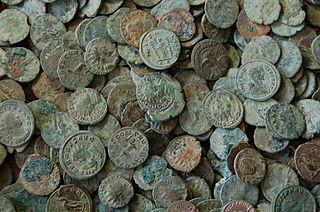
The Frome Hoard is a hoard of 52,503 Roman coins found in April 2010 by metal detectorist Dave Crisp near Frome in Somerset, England. The coins were contained in a ceramic pot 45 cm (18 in) in diameter, and date from AD 253 to 305. Most of the coins are made from debased silver or bronze. The hoard is one of the largest ever found in Britain, and is also important as it contains the largest group ever found of coins issued during the reign of Carausius, who ruled Britain independently from 286 to 293 and was the first Roman Emperor to strike coins in Britain. The Museum of Somerset in Taunton, using a grant from the National Heritage Memorial Fund (NHMF), acquired the hoard in 2011 for a value of £320,250.
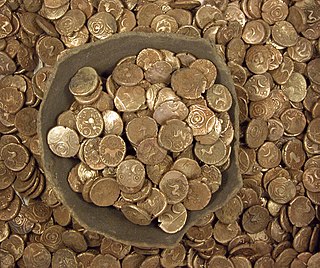
The Wickham Market Hoard is a hoard of 840 Iron Age gold staters found in a field at Dallinghoo near Wickham Market, Suffolk, England in March 2008 by car mechanic, Michael Dark using a metal detector. After excavation of the site, a total of 825 coins were found, and by the time the hoard was declared treasure trove, 840 coins had been discovered. The coins date from 40 BC to 15 AD.

The Bredon Hill Hoard is a hoard of 3,784 debased silver Roman coins discovered in June 2011 by two metal detectorists on Bredon Hill in Worcestershire, approximately 400 metres north of Kemerton Camp, an Iron Age hill fort. The coins were found in a clay pot that had been buried around the middle of the 4th century in a Roman villa, identified by the subsequent archaeological excavation. The coins include the reigns of sixteen different emperors during the mid to late 3rd century, and are the largest hoard of Roman coins to have been discovered in Worcestershire to date.

The Silverdale Hoard is a collection of over 200 pieces of silver jewellery and coins discovered near Silverdale, Lancashire, England, in September 2011. The items were deposited together in and under a lead container buried about 16 inches (41 cm) underground which was found in a field by a metal detectorist. It is believed to date to around AD 900, a time of intense conflict between the Anglo-Saxons and the Danish settlers of northern England. The hoard is one of the largest Viking hoards ever discovered in the UK. It has been purchased by Lancashire Museums Service and has been displayed at Lancaster City Museum and the Museum of Lancashire in Preston. It is particularly significant for its inclusion of a coin stamped with the name of a previously unknown Viking ruler.
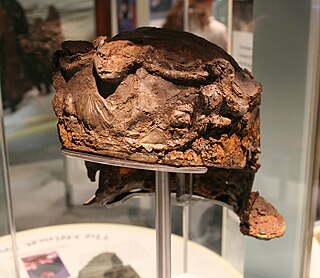
The Hallaton Helmet is a decorated iron Roman cavalry parade helmet originally covered in a sheet of silver and decorated in places with gold leaf. It was discovered in 2000 near Hallaton, Leicestershire after Ken Wallace, a member of the Hallaton Fieldwork Group, found coins in the area. Further investigation by professional archaeologists from the University of Leicester Archaeological Services discovered that the site appeared to have been used as a large-scale Iron Age shrine. Nine years of conservation and restoration have been undertaken by experts from the British Museum, supported by a Heritage Lottery Fund grant of £650,000. The helmet is now on permanent display at the Harborough Museum in Market Harborough alongside other artefacts from the Hallaton Treasure hoard.

The Snettisham Jeweller's Hoard is a collection of Romano-British jewellery and raw materials, found during the construction of a house in the Norfolk village of Snettisham in 1985. The hoard is thought to be the working stock of a jeweller, buried in a single clay pot around 155 AD. The finds include the working tip of a quartz burnishing tool, partially or fully completed items of jewellery, and raw materials: mainly silver coins, scrap silver items and silver ingots, but also six pieces of scrap gold, and many engraved gemstones to be set in rings. The presence of scrap gold and silver and absence of base metals indicates that the jeweller dealt mainly with high-status customers.
The archaeological sites Randlev and Hesselbjerg refer to two closely related excavations done throughout the 20th century near the village of Randlev in the Odder Municipality of Denmark, three kilometers southeast of the town of Odder. Randlev is known primarily for its Romanesque church constructed sometime around 1100 A.D. Hesselbjerg refers to the large Viking-Age cemetery discovered on the Hesselbjerg family farm and the site Randlev refers to the nearby settlement from the same period. Although both Randlev and Hesselbjerg were contemporaneous and encompass a similar area, Hesselbjerg refers more specifically to the 104 graves discovered prior to the later excavation at the site Randlev, which pertains to the Viking Age settlement. The settlement consisted of a farm complex that was likely active during the ninth and tenth centuries; finds from the site such as silver hoards and elaborate jewelry indicate that the farm was likely prosperous, a conjecture which is supported by the extremely fertile land surrounding the area. Artifacts were found in the vicinity of the Hesselbjerg and Randlev sites as early as 1932 when a local farmer discovered a silver hoard, but serious excavations were not conducted until 1963. These excavations ended in 1970; however, Moesgård Museum returned to the site in 1997 and continued analysis until 2010.
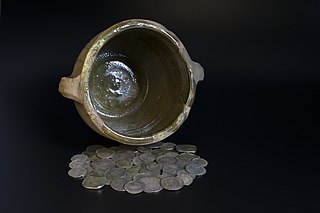
The Middleham Hoard is a coin hoard found near Middleham, North Yorkshire in England. It dates from the period of the English Civil War, and consists of 5,099 coins, all silver. It is the largest hoard of coins buried during the Civil War to have been discovered. The hoard was discovered in June 1993 by William Caygill while using a metal detector. Though referred to as one hoard, the coins were buried in three pots in two pits. These had slightly different deposition dates; likely in the later 1640s, though the person making the deposits was probably the same. The coins are dispersed between museums and private collections, 54 of them now in the Yorkshire Museum's numismatic collection.

Viking coinage was used during the Viking Age of northern Europe. Prior to the usage and minting of coins, the Viking economy was predominantly a bullion economy, where the weight and size of a particular metal is used as a method of evaluating value, as opposed to the value being determined by the specific type of coin. By the ninth century, the Viking raids brought them into contact with cultures well familiarised with the use of coins in economies of Europe, hence influencing the Vikings own production of coins.
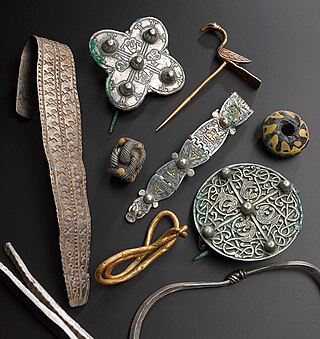
The Galloway Hoard, currently held in the National Museum of Scotland, is a hoard of more than 100 gold, silver, glass, crystal, stone, and earthen objects from the Viking Age discovered in the historical county of Kirkcudbrightshire in Dumfries and Galloway in Scotland in September 2014. Found on Church of Scotland land, the hoard has been described by experts as "one of the most significant Viking hoards ever found in Scotland". With years of extensive study and research, scholars are still not certain who buried the hoard, why they did so and whether they were Vikings or Anglo-Saxons. During the Viking Age, Galloway found itself squeezed between two Viking kingdoms and essentially cut off from other Anglo-Saxons in Britain - "Galloway is where these different cultures were meeting. It’s not just Scandinavians, but people from Britain and Ireland as well."
The Lenborough Hoard is a hoard of more than 5,000 late Anglo-Saxon silver coins, dating to the eleventh century, that was found at Lenborough in Buckinghamshire, England in 2014. It is believed to be one of the largest hoards of Anglo-Saxon coins ever found in Britain. It is now on display at Discover Bucks Museum.
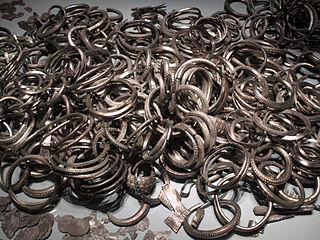
The Spillings Hoard is the world's largest Viking silver treasure, found on Friday 16 July 1999 in a field at the Spilling farm northwest of Slite, on northern Gotland, Sweden. The silver hoard consisted of two parts with a total weight of 67 kg (148 lb) before conservation and consisted of, among other things, 14,295 coins most of which were Islamic from other countries. A third deposition containing over 20 kg (44 lb) of bronze scrap-metal was also found. The three caches had been hidden under the floorboards of a Viking outhouse sometime during the 9th century.

The Balle Hoard, found in Balle, Djursland, is one of the largest 17th-century hoards ever discovered in Denmark. It consists of 12,121 coins, a silver tankard, a smaller silver cup, jewellery and garment components. The youngest of the coins date from 1658, indicating that the hoard was buried during the early stage of the Second Northern War when Charles X Gustav of Sweden's troops ransacked Jutland.
















